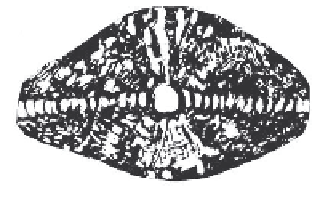Geology Reference
In-Depth Information
Plate 72 Late Cretaceous Benthic Foraminifera
Benthic foraminifera allow the biostratigraphic zonation as well as the facies differentiation of platforms and
ramps. Middle and Late Cretaceous miliolinid alveolinids (e.g.
Praealveolina, Ovalveolina, Cisalveolina,
-> 2)
are abundant in inner parts of carbonate platforms (De Castro 1980, 1988). The large discoidal or lenticular tests
of the orbitoidacean foraminifera (-> 5-10) are characterized by radially hyaline and perforated tests, cyclically
arranged equatorial chambers and more or less regular lateral chambers arranged in annular cycles (-> 7).
Orbitoidacean foraminifera are abundant in Campanian and Maastrichtian outer platform and upper slope car-
bonates. The plate exhibits agglutinated textulariid, miliolinid and rotaliinid foraminifera.
1
Nezzazata
Omara. The systematic position of the genus is doubtful. Oblique section of the
trochospiral test. Calcitic wall. Genus range: Albian to Turonian. The maximum diversification
and spreading of this genus and morphologically related foraminifera occurred in the Cenoma-
nian. The sample is from Cenomanian inner platform deposits in the subsurface of Ras al Khaimah,
United Arabian Emirates. Left figure: Exterior view of the trochospiral plano-convex test (after
Loeblich and Tappan 1964).
2
Cisalveolina fallax
Reichel. Miliolina, Alveolinidae. Right: Oblique equatorial section of a megalospheric test. Left:
Tangential section. Note the numerous chamberlets produced by septules. Genus range: Cenomanian. The sample is from
the Cenomanian Mishrif Formation: Subsurface, Ras al Khaimah, United Arabian Emirates.
3
Agglutinated foraminifera.
Chrysalidina
d'Orbigny (bottom, axial section); associated with orbitolinids (top). Note the
large initial chamber (arrow) of the conical triserial test and the low and strongly overlapping chambers. Thick, finely
agglutinated wall. Time range of
Chrysalidina:
Cenomanian-Turonian. Same locality as -> 2.
4
Cuneolina
d'Orbigny. Textulariina, Ataxophragmiacea. Oblique section. Common in inner shelf platform settings. Ge-
nus range: Valanginian to Santonian. Late Cretaceous: Subsurface, Ras al Khaimah, United Arabian Emirates.
5
Siderolites
Lamarck. Rotaliina, Rotaliacea. Note the hyaline wall struc-
ture and the distinct spines (arrow) arising near the initial chamber in
the plane of coiling. White grains are quartz. Common in upper slope
environments.
Maastrichtian: Subsurface, Saudi Arabia.
6
Lepidorbitoides
Silvestri, embedded in an echinoderm packstone.
Rotaliina, Orbitoidacea. Oblique section of the flattened, lenticular test.
This is an example of poorly preserved tests that are rather common but
that can be still determined at higher taxonomic levels, allowing a rough
age assignment. Genus range: Campanian to Maastrichtian. Late Cre-
taceous: Northern Tunisia. The sample is a mosaic stone, used for the
decoration of Punian houses in ancient Carthage. Microfacies and age
indicates a source of the material within a distance of at least fifty kilo-
meters.
7
Orbitoides
d'Orbigny. Rotaliina, Orbitoidacea. Axial section. Taxonomic
criteria of these larger foraminifera are the early ontogenetic stages re-
flected by the initial chamber and the subsequently formed chambers.
Note the differentiation of a median equatorial layer of chambers (E)
and lateral chambers (L). Genus range: Latest Santonian to Maastrich-
tian.
Orbitoidacean foraminifera are common in upper slope environ-
ments. Maastrichtian: Wietersdorf, Carinthia, Austria.
8
Orbitoides.
Vertical section. Diagnostic criteria are the arrangement and
size of the equatorial chambers and the distribution of the radiating
calcite pillars (P) within the lateral part of the test. The pillars give rise
to granules on the outer surface. Same locality as -> 7.
9
Orbitoides
. Axial section of the megalospheric iuvenarium. The arrow
points to the diagnostically important trilocular embryonic chambers,
surrounded by a thick perforated wall. Note the equatorial chambers
with curved walls and the smaller lateral chambers. Same locality
as -> 7.
10
Orbitoides
. Vertical section. Note the embryonic chambers and the
smaller lateral chambers. Same locality as -> 7.
Siderolites calcitrapoides
. Late Maastrichtian
open marine shelf margin facies characterized
by an assemblage of larger foraminifera, dasy-
clad algae and rudist debris. Salento Peninsula,
Puglia, Southern Italy. Scale is 1 mm.
Axial section of
Orbitoides
displaying the ini-
tial chamber and cyclically arranged equatorial
chambers, surrounded by rows of lateral cham-
bers.
-> 5 and figure on this page: Parente 1997



